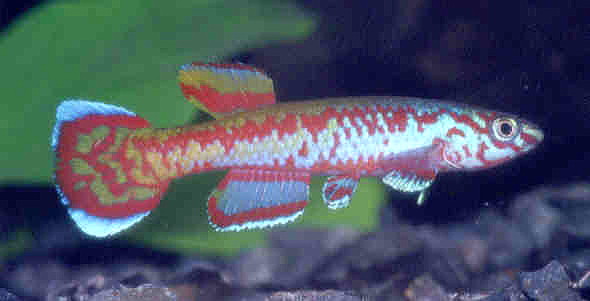

A.exigoideum. Photo courtesy of Ed Pürzl
| Meaning of Name |
To resemble exiguum. | ||||||||||
| First Description |
Radda A.C. & Huber J.H. 1977. Cyprinodontiden Studien in Gabun - V. Das Tiefland West-Gabuns und die Mayumbe-Berge. Aquaria 24 : pages 141-143 (some publications quote pages 137-150) figure 2, 6. | ||||||||||
| Size |
5 cm | ||||||||||
| Meristics |
D = 11-12, A = 13-14, D/A = +5-6, ll = 29-31 (Radda & Huber 1977) | ||||||||||
| Karyotype |
n = 11, A = 21 (Scheel 1981) | ||||||||||
| Sub-Genus |
Mesoaphyosemion | ||||||||||
| Group |
striatum | ||||||||||
| Synonyms |
None | ||||||||||
Populations
|
BWW 00/2 -
Mandilou -
Ngoudoufola -
| ||||||||||
| Type Locality |
A little confusing as both locations are given as the type locality in various publications. Wildekamp in 'World of Killies 1' states Mandilou, where they were found in a small brook in the rainforest. Other reports state:- Ngoudoufola. A broad river. | ||||||||||
| Distribution |
Fairly restricted to the Ngoudoufola - Mandilou area of Gabon where they inhabit the middle N'Goumé River drainage. | ||||||||||
| Habitat |
Brooks, swampy areas, small rivers & forest
streams. Measurements taken at Ngoudoufola were pH 7·5, DH 12, water temperature 21°C (also measured at 21·9°C). This biotope was a broad river 12 - 25 metres wide with a water depth of 15 - 30cm. | ||||||||||
| Distinguishing Characteristics | A.exigoideum is easily recognisable from other Aphyosemion sp. by their bright red colouration which is quite heavy especially on the Mandilou population which has a broader red crescent on the caudal fin. | ||||||||||
| Colour/Pattern Variability |
Fairly low. This sp. has a small
distribution area. Variation has been reported in the outer margins
of the caudal fin which can be bluish white or yellow (blue phase &
yellow phase). Some populations have red lines running top & bottom
of the body whilst others have vertical spots forming lines on the body/
Some drawings of fish I kept early '80's |
||||||||||
| History |
Collected by Dr.J.H.Huber & A.C.Radda on their expedition to Gabon in July 1976 at Ngoudoufola & Mandilou in a small forest river. Radda took many pairs to the 1978 AKA Convention. Ed Pürzl brought this sp.( G31/76 ) into the UK in 1978 & these were distributed in the Kent & Wessex area. | ||||||||||
| Breeding Notes |
This sp. is a non-annual with a 16 - 21 day incubation period (some reports state 12-15 days). Experimentation has proved that eggs can be successfully dry stored for 3 - 4 weeks. Fry which I raised appeared very slow growing but sexed out evenly. When fed exclusively on Daphnia it was noted that the males lost all their bright red colouration & became a washed out pink colour. The fry I raised were slow growing
but evenly sexed bred in water of pH 8, DH 10. Other reports suggest sexual maturity
is attained as little as 4 months. Fred Wright reported in a BKA I/P that eggs dry or semi dry required at least 16 days before attempting wetting. Fry were reportedly in need of infusoria as a first food. Growth was not rapid suggesting a long lived fish. Peter Watkins in BKA newsletter No.176, April 1980 (Repeated in No. 365, February 1996) gave a breeding report stating that eggs were found in floating Riccia & bottom mops. Water was hard tapwater (DH 15, pH 7·8). In this hard water the eggs eyed up well but many died after 10 days. He later placed the eggs in rainwater with better results. | ||||||||||
| Diameter of Egg | 1.3 - 1.6mm. | ||||||||||
| Remarks |
Fred Wright regarded this as one of the most colourful
sp. from the Gabon - Radda/Huber collection & I'm inclined to agree with him.
Not a prolific spawner but well worth the effort in breeding a few pairs. |